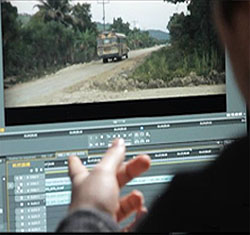
So let’s say we have a compressor running in the background of a female interview.
We can safely dial up a HPF with a pivot frequency of 165 and not lose any of her voice. We can take it up even higher to eliminate more of the noise, and the clarity will improve markedly.
In fact, the voice will “sound” louder once the low frequency stuff is removed because we can hear it better. So this is exactly what we did for grocery store woman. We dialed up an HPF with a pivot at around 150 Hz, and it totally transformed the audio.
There was still some higher frequency noise, and it was obvious she was standing in the store and not a studio, but the clarity of her voice was improved substantially.
Now, earlier I mentioned we actually have two tools in our tool belt. The other one may be on the mic itself. Many professional shotgun mics (and some interview mics, and the occasional lapel mic) have a HPF built in.
For example, my beloved Audio-Technica 835B has a switchable roll off at 180 Hz at 12 dB per octave.
That means at the lowest fundamental of a male voice the mic will be 12 dB down, which is generally not a big deal unless you’re interviewing James Earl Jones.
Normally, I like to leave this switched on because it eliminates a lot of room rumble, AC noise and other “nasties” right at the source. It’s just a good idea. If you use this when you shoot, you will require less processing in the edit suite.
Of course, you’ll want to listen to it through some good headphones first to make sure you’re happy with the sound.
You do have good headphones, right?
Mike Sessler now works with Visioneering, where he helps churches improve their AVL systems, and encourages and trains the technical artists that run them. He has been involved in live production for over 25 years and is the author of the blog Church Tech Arts.
